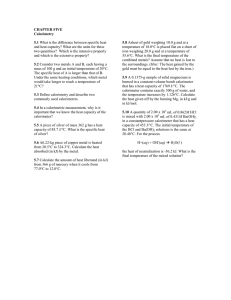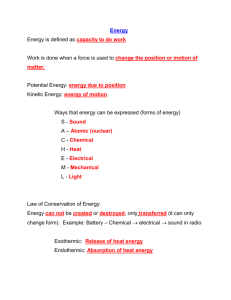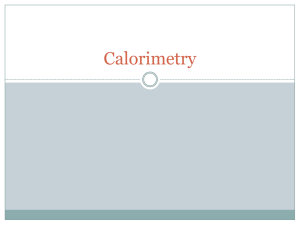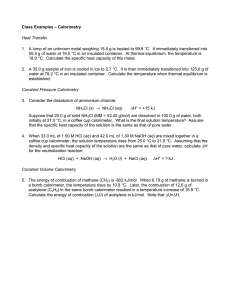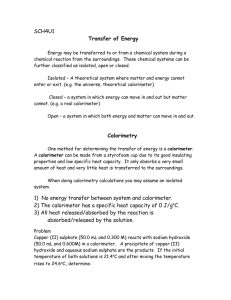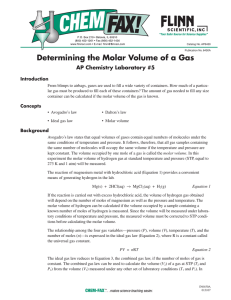Lab Procedures and Techniques Mr.Langella
advertisement
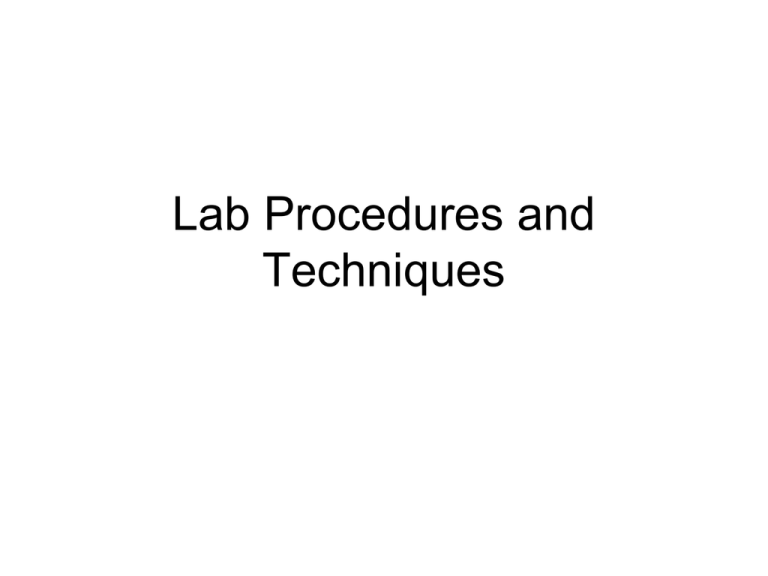
Lab Procedures and Techniques Calorimetry • Calorimetry is used to determine the heat released or absorbed in a chemical reaction. A calorimeter can determine the heat of a solution reaction at constant pressure Techniques: • Use a double Styrofoam cup with a plastic top and hole for the thermometer • Determine the change in temperature accurately • Measure solution volumes precisely • Start with a dry calorimeter Formulas Information to know about calorimetry: • Heat capacity (C) = the amount of heat needed to raise the temperature of an object by one degree Celsius or Kelvin, J/°C or J/K. • The heat capacity of 1 mol of a substance is called its molar heat capacity (Joules per mole per degree) J/mol°C or J/molK. • Specific heat, c, also known as specific heat capacity, is defined as the amount of heat necessary to raise the temperature of 1.00 g of a substance by one degree. Units are (joules per gram per degree), J/g°C or J/gK. • You often use the specific heat capacity in analyzing gathered data then convert to molar heat capacity. Assumptions often made during calorimetry: • (Be able to answer error analysis questions about each assumption below) • The density of dilute solutions is the same for water. D= 1.0 g/mL • The specific heat of the solutions is the same as that for water. c = 4.184 J/goC • The solutions react in their Stoichiometric amounts. • There is no loss of heat to the surroundings. The energy change associated with the process in which a solute dissolves in a solvent is called the Heat of Solution. • This energy change is the net result of two processes, the energy required to break the solute-solute bonds, called the crystal lattice energy, and the energy released when the solute particles bond with the solvent molecules, called the heat of hydration. Heat of Solution • Calculate the number of moles of your assigned solid dissolved in each of your trials. Massofsolu te( grams) Molesofsol ute Formulamassofsolute( grams / mole) Step One • Change in energy of the water, • Δq1 = total mass of material x specific heat (4.18 joules/gC) x Δt If they give you a calorimeter constant • Calculate the energy absorbed or released by the calorimeter from the calorimeter constant obtained in an earlier experiment and the change in the temperature of the water. Where • Change in energy of the calorimeter, Δq2 = calorimeter constant x Δt Total Heat • Calculate the total energy absorbed or released by the solution process from the sum of the change in energy of the water plus the change in energy of the calorimeter, • Total energy, Δqt = Δq1 (Aqueous Solution) + Δq2 (calorimeter) • Calculate the heat of solution from the number of moles of salt dissolved (Q1) and the amount of heat liberated or absorbed when the salt dissolves (Q2c). • Convert this value from joules/mol to kilojoules/mole. NOTE: 1000 joules = 1 Calculating Molar Heat of Reaction Titration Technique Technique continued Calculation based on Stoichiometry Calculations Example Titration Curve Point at which pKa = pH 4.8 Equivalence Point One-half the equivalence point Gravimetric Analysis Chloride Analysis Determining Molar Mass Using Freezing Point Depression Data Graphical Data Using Titration MW of Volatile Liquid Spectrometric Analysis
